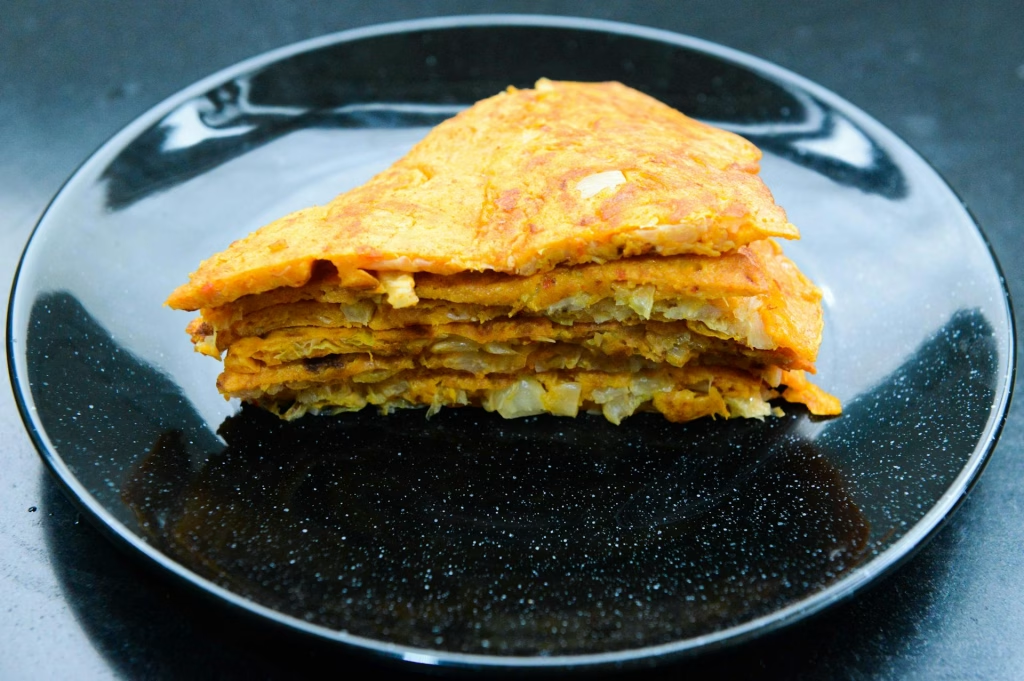When it comes to the universal language of breakfast, there’s one meal that truly knows no borders: the humble omelette.
Providing the perfect blank canvas for a myriad of fillings and flavors, the omelette is a versatile and delightful dish.
Our guide will not only show you how to make a basic omelette but also suggest a variety of scrumptious fillings that will bring your breakfast game to new heights.
Table of Contents
Ingredients:
For the Basic Omelette:
- 2 large eggs
- Salt, to taste
- Pepper, to taste
- 1 tablespoon of butter or olive oil
This recipe serves one person, but it can easily be multiplied to serve more.
Estimated Time: 10-15 minutes
Preparation:
- Whisk the eggs: Crack the eggs into a bowl and whisk them until the yolks and whites are fully combined. Season with salt and pepper.
- Heat the pan: Warm a non-stick frying pan over medium heat. Add butter or olive oil, and let it melt, ensuring it coats the whole surface of the pan.
- Pour in the eggs: Once the butter is sizzling, pour in the whisked eggs. Let them cook undisturbed for a few moments until they start to set around the edges.
- Cook the omelette: Tilt the pan to let the uncooked eggs flow into the open spaces. Do this a few times until the eggs are mostly set but still slightly runny on top.
- Add the filling: On one half of the omelette, spread your chosen fillings (more on that below). Avoid overstuffing to ensure the omelette can be folded easily.
- Fold and serve: Using a spatula, fold the omelette in half over the filling. Slide it onto a plate, and voilà, your basic omelette is ready to serve!

Nutritional Facts (per serving):
- Approximately 210 calories
- 14 grams of fat
- 18 grams of protein
- 1 gram of carbs
(This can vary based on the type of fillings used.)
Variety of Fillings:
- Cheese and Ham: A classic combination that never fails. You can use any cheese you like – cheddar, gouda, or mozzarella are great choices.
- Mushroom and Spinach: Sauté some mushrooms and spinach for a delicious and healthy vegetarian option.
- Tomato, Basil, and Mozzarella: This Italian-inspired filling will make your omelette taste like a Caprese salad.
- Bacon and Avocado: Crispy bacon and creamy avocado are a match made in heaven. This filling is packed with protein and healthy fats.
- Smoked Salmon and Cream Cheese: For a more luxurious breakfast, this filling is sure to impress.
Tips and Tricks:
- Experiment with different fillings to keep your omelettes exciting and diverse.
- For a creamier texture, you can add a dollop of cream cheese or sour cream to the egg mixture.
- Don’t be afraid to get creative with herbs and spices to enhance the flavor of your omelette.
- If you’re a fan of a well-cooked exterior with a slightly runny interior, cook the omelette on slightly higher heat for a shorter time.
- Remember to adjust the filling quantities based on the size of your omelette and personal preference.

History of Omelette
- The history of the omelette dates back centuries, with its origins rooted in ancient Persia and medieval Arab cuisine.
- The word “omelette” is believed to have French origins, and the dish gained popularity in France during the 16th century.
- The French cookbook “Le Cuisinier” by François Pierre La Varenne, published in 1651, includes one of the earliest recorded omelette recipes.
- Omelettes became a culinary staple across Europe, with variations emerging in Spain, Italy, and England over the centuries.
- In the 18th century, omelettes gained favor in England, with cookbooks featuring diverse recipes and techniques.
- The simplicity of the omelette made it accessible to people of various socioeconomic backgrounds, contributing to its widespread adoption.
- Immigrants and explorers brought the omelette to different parts of the world, influencing regional variations and ingredient choices.
- The omelette’s popularity surged in the 19th and 20th centuries, becoming a classic breakfast or brunch option in many cultures.
- Contemporary chefs have embraced the omelette as a canvas for creativity, experimenting with unique fillings and presentation styles.
- Today, the omelette remains a beloved and versatile dish enjoyed globally, reflecting its rich history and adaptability in various culinary traditions.

Remember, the key to a great omelette is creativity. Don’t be afraid to experiment with different fillings based on your preference.
Whether you’re a cooking novice or a seasoned chef, the art of making an omelette is a valuable skill to have.
With our guide, you can enjoy a hearty, healthy, and customizable meal any time of the day. So grab your spatula and let’s get cooking!
Frequently Asked Questions (FAQs) for Omelette Recipes:
- Can I use egg substitutes in place of real eggs? Yes, you can use egg substitutes like egg whites or vegan alternatives. Keep in mind that the texture and flavor may vary slightly, but it’s a great option for those with dietary restrictions or preferences.
- How do I prevent my omelette from sticking to the pan? Using a non-stick skillet and ensuring it’s properly coated with butter or oil before pouring in the eggs will help prevent sticking. Also, make sure not to overheat the pan.
- Can I prepare omelettes in advance? While omelettes are best enjoyed fresh, you can prepare some of the ingredients in advance, such as chopping vegetables or pre-cooking meats. However, it’s recommended to cook the eggs just before serving for the best taste and texture.
- What’s the secret to a fluffy omelette? Whisking the eggs thoroughly and incorporating air into the mixture is key to achieving a fluffy texture. Cooking over medium heat and folding the omelette while it’s still slightly runny also contributes to fluffiness.
- How do I know when the omelette is cooked? The omelette is cooked when the edges are set, and the center is still slightly runny. You can check by lifting the edges with a spatula; if they hold their shape and the underside is golden brown, it’s ready to fold.
- What are some creative filling ideas? Get creative with your omelette fillings! Try combinations like spinach and feta, mushroom and Swiss cheese, or ham and cheddar. Experiment with different herbs, spices, and even leftover roasted vegetables.
- Can I make a large omelette for a group of people? Yes, you can scale up the recipe based on the number of servings needed. Use a larger skillet and adjust the quantities of eggs and fillings accordingly.
- Can I freeze omelettes for later? While it’s not recommended to freeze cooked omelettes, you can prepare and freeze individual portions of cooked and chopped vegetables or cooked meats. When ready to enjoy, simply reheat and add them to freshly cooked eggs.
- How do I avoid an overcooked or dry omelette? Cook the omelette over medium heat and avoid overcooking. It’s essential to fold the omelette while the center is still slightly runny, ensuring a creamy and moist texture.
- Can I make a sweet omelette? Absolutely! Sweet omelettes can be made by adding ingredients like sugar, vanilla extract, and sweet fillings such as berries, Nutella, or even a dusting of powdered sugar. Adjust the recipe to suit your sweet tooth.
Remember, mastering the art of omelette-making often involves a bit of experimentation, so feel free to customize the recipe to your liking and enjoy the delicious results!


